- Basic Agile Interview Questions
- Advanced Agile Interview Questions
- Agile Interview Questions - Testing (Basic + Advanced)
- Agile Interview Questions- Methodology [Basic+ Advanced]
- Tips to help you prepare for an Agile interview as a developer
- Tips to help you prepare for an Agile interview as a manager
70+ Agile Interview Questions And Answers For 2025 Job Interviews
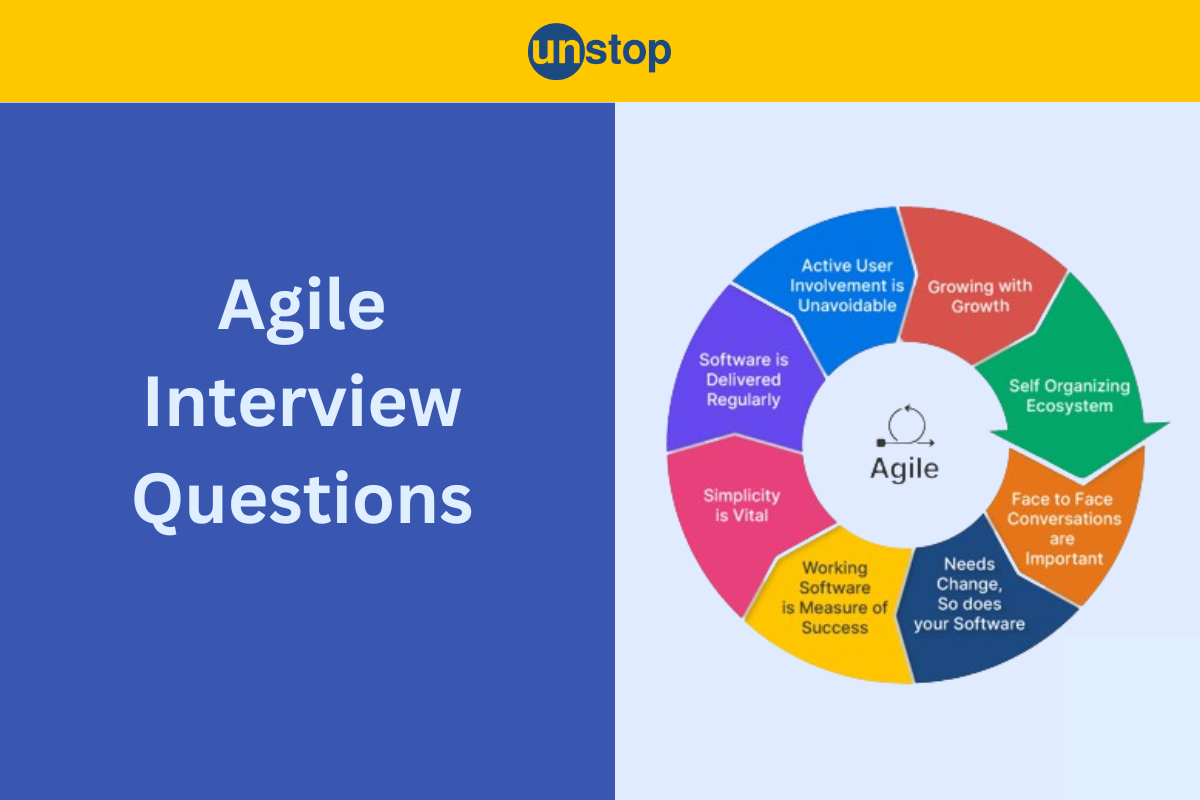
Agile is a flexible method of creating software and conducting project management focusing on teamwork, flexibility, and customer-orientedness. Key attributes of Agile include brief development cycles, increased feedback loops, and continual refinement to enhance the overall process.
Organizations must be agile to react quickly to changing market demands or customer needs. This ensures transparency, boosts collaboration, and cuts expensive last-minute adjustments. Customer feedback is important in ensuring that the final product conforms to what was expected and remains competitive for Agile.
Agile methodologies, such as Scrum, Kanban, and Lean, help divide projects into small and manageable chunks for organizations. They help make teams cross-functional and, in an incremental approach, provide products developed in short intervals. Regular reviews, retrospectives, and adaptive planning allow for constant adjustments. Agile promotes flexibility, quality, and customer satisfaction, making it a preferred choice for modern project management and software development.
In this article, we will cover Agile interview questions for different difficulty levels to help you in your interview prep.
Looking for a job in the software development domain? Find jobs at Unstop
Basic Agile Interview Questions
Q1. What is Agile, and how does it differ from traditional project management?
An Agile approach is an adjustable method of projects emphasizing frequent client involvement, response to changes, and gradual developments. In contrast to the inflexible planning used in the conventional approach, agile facilitates modifications and prioritized feature selection during the project execution period, improving adaptability and customer satisfaction.
Q2. What are the major premises of the Agile Manifesto?
The Agile Manifesto consists of four core values and twelve principles. Some key principles include
- Responding to change over following a plan,
- Prioritizing customer collaboration over contract negotiation
- Delivering working software frequently to satisfy customers
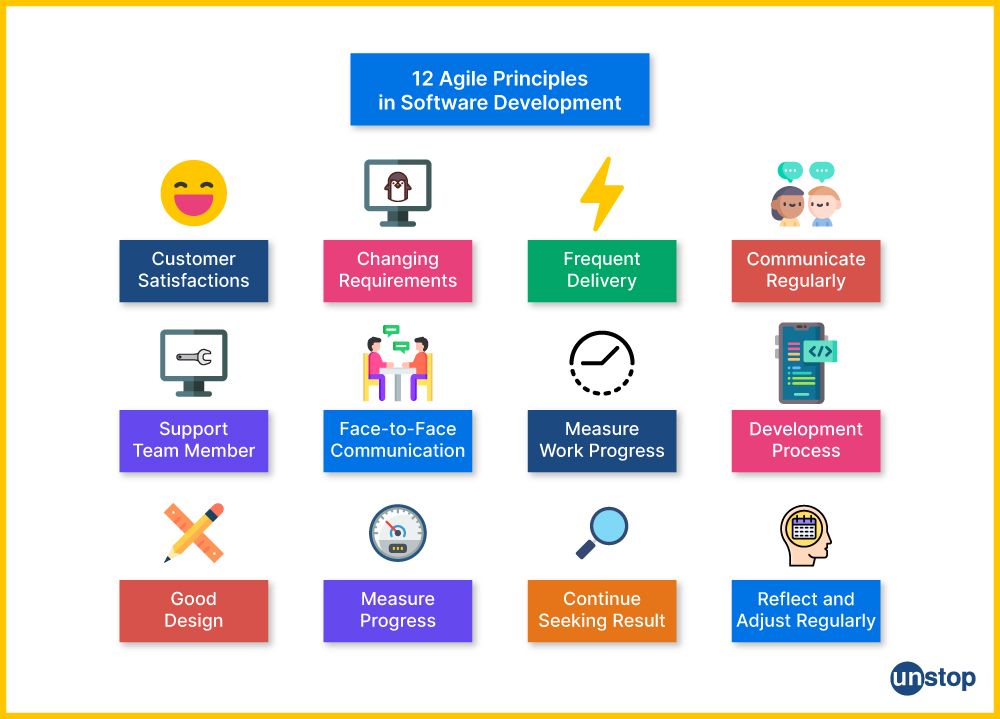
Q3. Can you explain the Scrum framework?
One of the Agile techniques that has emerged is a framework called Scrum. It involves small and autonomous groups with a limited period of operation within the duration known as sprints.
Key roles in Scrum include:
- Product Owner: In charge of specifying and arranging the product backlog, speaking on behalf of a customer/end-user.
- Scrum Master: This is the person on the team who ensures Scrum practices are followed and solves any problems encountered by the team.
- Development Team: Professionals organized into a self-directed team that would deliver the product.
Key Scrum events include:
- Sprint Planning: Every sprint starts with the planning phase, where new work is planned for the team.
- Daily Standup: Daily five-minute meetings about what is being done and any concerns.
- Sprint Review: The team shows what it has done by the end of every sprint to the stakeholders.
- Sprint Retrospective: A post-event discussion with the team about what worked and what failed.
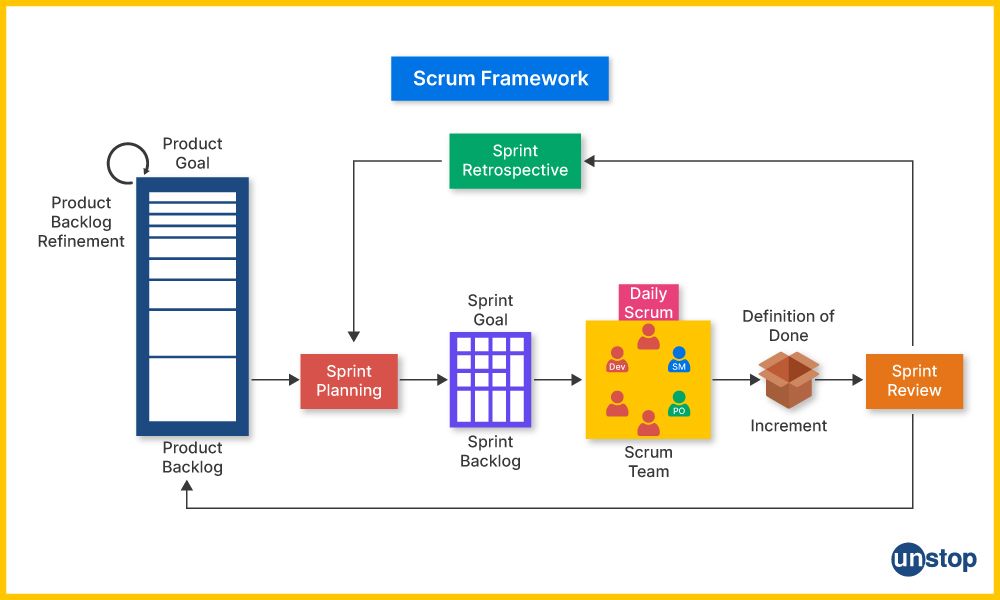
Q4. What is a User Story in Agile, and how is it different from a traditional requirement document?
A User Story is a brief description, as seen by the user, about one feature. In most instances, it is usually presented in a plain, straightforward manner, like “As a [user role], I would like [action] because of [benefits].”
User stories foster communication among developers and stakeholders through user-centered requirements instead of elaborate technical descriptions. Unlike requirements documents, they are less formal, more customer-focused, short, detailed, and written in simple language.
5. How do you prioritize the product backlog in Agile?
A key component of the Agile process is prioritizing the product backlog, which guarantees that the team focuses on the most important and high-priority items first. Prioritizing the product backlog usually involves the following steps:
- Product Owner Involvement: The Product Owner represents stakeholders' interests. They work with stakeholders to learn about their requirements, get their input, and match the backlog to the overarching business plan.
- User Stories and Epics: Divide the project into epics and user stories for features or functionalities. These are fundamental components that provide fine-grained prioritization.
- Value and ROI: Evaluate each epic or user story's contribution to the project, then rank them in order of importance based on ROI. The highest-value items or those meeting important business requirements should be at the top.
- Dependencies: Take into account any connections between epics or user stories. Prioritizing tasks makes sense when they are dependent on one another's completion.
- Risk mitigation: Prioritize items that deal with possible hazards at the outset of the development process. This guarantees that possible obstacles are addressed beforehand and aids in the management of uncertainty.
- Consumer Feedback: Consistently take into account input from consumers or end users. Priority should be given to items directly addressing consumer feedback or needs to increase customer satisfaction.
- Continuous Improvement: Setting priorities is a continuous process rather than a one-time event. The backlog should be regularly trimmed based on shifting business priorities, shifting market dynamics, and new prospects.
Q6. What is Agile's Definition of Done (DoD), and why is it important?
The 'Definition of Done' is a shared understanding within the team of what "done" means for each work item. It ensures that all necessary quality and acceptance criteria are met before an item is considered complete. Having a clear DoD enhances transparency and product quality.
The DoD is significant because of:
- Consistency and Clarity: DoD points out to the stakeholders and team what "done" means for each increment. It eliminates uncertainty and determines clear expectations.
- Quality Assurance: By defining specific benchmarks, the DoD ensures that every deliverable meets the required quality requirements. It covers aspects ranging from user experience to security, performance, and functionality.
- Transparency: DoD enhances transparency by ensuring all parties involved can see the completion criteria. Transparency between team members and stakeholders also facilitates effective communication, which helps avoid misunderstandings.
- Risk Reduction: A precise DoD reduces the chances that defects or issues may slip through undetected. It lowers the chances of problems when a work is released because it ensures that the team has covered all angles before declaring it complete.
- Continuous Improvement: Teams can build upon the Department of Defense as a starting point and adapt to new requirements, best practices, and technology trends through regular evaluation and revision of DoDs. This way, they can change their understanding of "done" to fit the needs of a project.
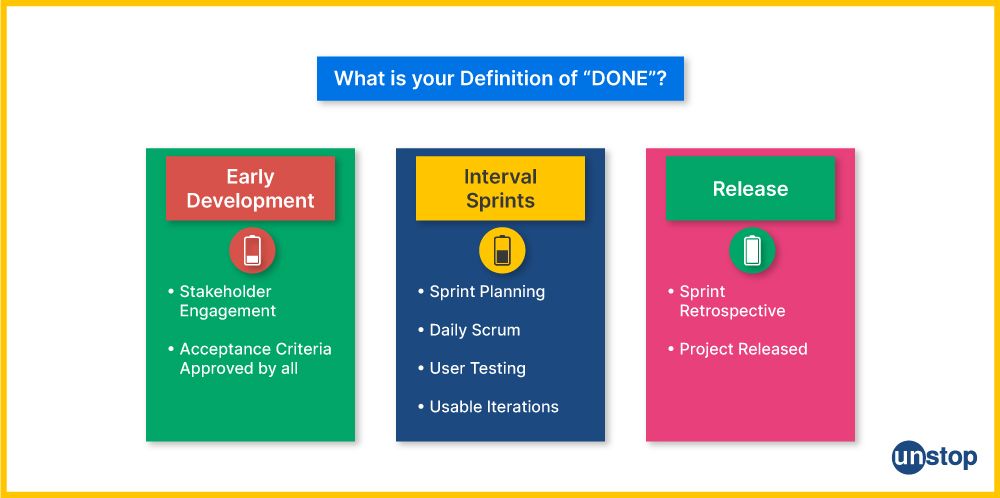
Q7. How do you handle changing requirements in an Agile project?
Change requirements are always welcomed in Agile, as it is flexible enough to adapt. The project must include changes that should be prioritized and integrated on time. The team should also communicate freely with stakeholders to avoid conflicts involving changes related to the project.
Q8. What are the advantages and disadvantages of Agile?
Benefits of Agile include:
- Faster delivery of value.
- Cost reduction through a shorter development cycle.
- Increased productivity resulting from continuous improvement.
- Reduced risks compared to the waterfall approach.
- Improved customer satisfaction.
- Better adaptability to change.
However, Agile is not appropriate for all projects, and it demands collaborative input with full ownership in place for every single stakeholder. Agile projects can also present challenges when it comes to documentation.
Q9. What is the role of a Scrum Master in a Scrum team, and how does it differ from that of a Product Owner?
A Scrum Master's responsibilities in a Scrum team are varied, but their main goal is to help the team efficiently apply the Scrum framework. To make sure that the Scrum process is comprehended, accepted, and successfully carried out, the Scrum Master is essential.
The key roles of Scrum Master:
- Simplifying the Scrum Process
- Removing impediments
- Ensuring the team follows agile practices
|
Aspect |
Scrum Master |
Product Owner |
|
Primary Focus |
Facilitating the Scrum process and team dynamics, removing impediments, and ensuring adherence to Scrum principles. |
Representing the interests of stakeholders, defining and prioritizing the product backlog, and ensuring the delivery of value. |
|
Responsibility for the Team |
Focuses on the team's well-being, productivity, and continuous improvement. Acts as a servant-leader to the team. |
Advocates for the product vision, make decisions on backlog prioritization and ensure the team delivers features aligned with business goals. |
|
Impediment Resolution |
Actively identifies and removes impediments that hinder the team's progress. |
Typically not involved in day-to-day impediment resolution. Raises significant impediments to the Scrum Master. |
|
Collaboration |
Collaborates with the team, Product Owner, and stakeholders to ensure smooth communication and understanding of goals. |
Collaborates with the development team, consumers, and stakeholders to identify and rank features and user stories. |
|
Decision-Making Authority |
Limited decision-making authority. The focus is on enabling the team to make decisions collectively. |
Has decision-making authority regarding the content and prioritization of the product backlog. |
|
Metrics and Progress Tracking |
Monitors and communicates team progress using Agile metrics. Facilitates Sprint Planning, Daily Stand-ups, Sprint Review, and Sprint Retrospective meetings. |
Measures progress based on the delivery of value to customers. Collaborating with the team, refines and modifies priorities in response to input and evolving business requirements. |
|
Customer Interaction |
May interact with customers or stakeholders to gather feedback and understand their needs. |
Actively engages with customers and stakeholders to capture requirements, provide updates, and gather feedback on delivered increments. |
Bag a job as a scrum master at top firms! Search and apply now
Q10. What is a Sprint in Scrum, and how long does it typically last?
In Scrum, Sprint refers to a specified period within which some work is done. Sprints usually run for a period of two to four weeks, depending on the specific preferences and requirements of each team. The team develops one or more potential shippable products within a sprint while working on prioritized user stories from the backlog. Sprint is of fixed duration, thus instilling urgency with a regular cadence of the team’s performance.
Q11. How does Agile address risk management in projects?
The Agile approach mitigates risks through continuous feedback, openness, and flexibility. The fundamental reason behind this is that giving out numerous operating increments on time can help identify the risks early in the process. Here are some ways Agile approaches to risk:
- Regular Feedback: The teams can get feedback from stakeholders frequently, leading to quick recognition of potential issues and risks.
- Transparency: Daily standup meetings, as well as burn-down charts, ensure that there is a transparent approach when it comes to project progress and possible issues.
- Flexibility: This reduces the probability of project failure by allowing agile teams to reschedule the plan in view of change factors and feedback.
As a result, Agile requires that risk management takes place continually and involves the whole team in identifying and reducing risks.
Q12. Can you explain the Continuous Integration and Continuous Deployment (CI/CD) concept in Agile development?
Continuous Integration (CI) frequently merges code changes into a shared repository, enabling automated testing and early error detection. Continuous Deployment (CD) automatically deploys code to production when it passes all tests. CI/CD streamlines development, reduces deployment risks and ensures a consistent release process.
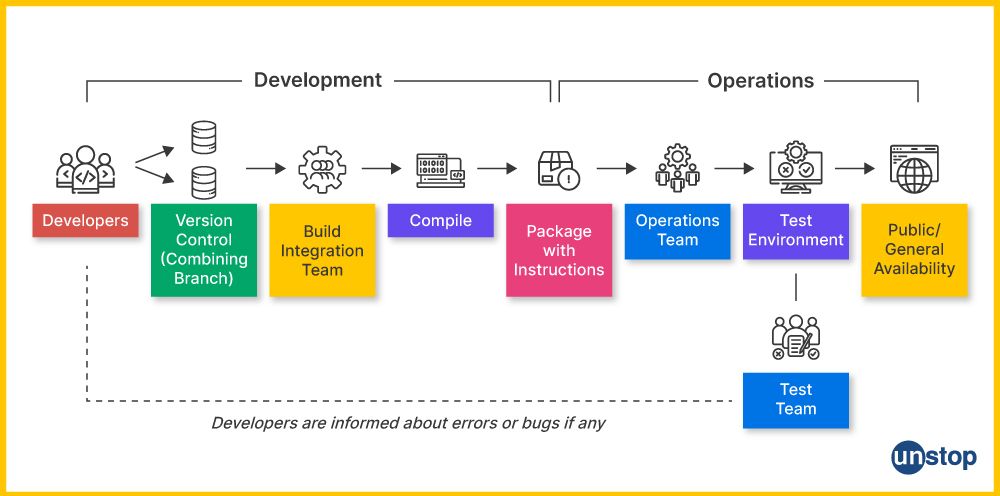
Q13. How does Agile promote collaboration among team members and stakeholders?
Agile methodologies have their foundation in principles of collaboration, whereby open communication is practiced by all team members and stakeholders while being flexible on the roles undertaken. Here's a detailed explanation of how Agile promotes collaboration:
- Cross-functional Teams: Agile promotes the development of cross-functional teams that involve team members with various skills and subject matter expertise. In this composition, team members can work together on various aspects of a project that encourages the collective problem-solving approach and shared responsibility for tasks.
- Iterative Development: Agile uses iterative development cycles, so-called sprints in Scrum, with small functional increments of a product being delivered regularly. This process is iterative because collaboration and feedback can occur frequently, ensuring the final product matches stakeholders' expectations.
- Frequent Communication: Agile methodologies focus on consistent and open communication. Daily stand-up meetings, sprint planning sessions, review meetings, and retrospectives offer regular opportunities for team members and stakeholders to discuss current progress ratings challenges or impediments they have encountered together with any needed adjustments.
- Customer Involvement: In agile, there is a high level of customer collaboration throughout the development process. A product that reflects customers' true needs and expectations can be achieved by regularly integrating their feedback through interactions with them.
- Product Backlog Prioritization: The Product Owner works with stakeholders to develop and rank the product backlog. This collaboration ensures that the team focuses on the most valuable and high-priority features to align with all business goals in terms of development.
- Adaptability to Change: Agile welcomes change and encourages evolving requirements, even at a late development stage. This flexibility enables teams to adapt quickly when getting a new insight or priorities change, leading to the spirit of collaborative behaviour that adapts easily due to problems related to projects being in constant evolution.
Q14. What are the most typical Agile metrics for evaluating a project’s performance?
Common Agile metrics include:
- Velocity (the amount of work completed in a sprint).
- Burn-down and Burn-up charts (visualizing work progress).
- Lead Time (time from the start to the completion of a user story).
- Cycle Time (time from when work starts until it's delivered).
These metrics help teams track progress and identify areas for improvement in their Agile processes.
Advanced Agile Interview Questions
Q15. What does DevOps entail, and how does it connect with Agile approaches?
DevOps is an approach that aims to foster communication and collaboration between IT operations and software development. It entails the automatic execution of processes for quicker and dependable software delivery.
DevOps extends collaboration and automation of processes associated with software development all through the Agile methodologies cycle. Similarly, DevOps and Agile try to improve flexibility, responsiveness, and the capability of delivering effective software products through collaboration and continuous improvement.
Q16. Explain the concept of large-scale Agile and what are the frameworks used for large-scale Agile implementations.
Large-scale Agile refers to the application of Agile principles and practices in the context of complex projects involving multiple teams and extensive organizational structures. Several frameworks are used for large-scale Agile implementations, including:
- SAF(Scaled Agile Framework): SAF remains one of the most prominent agile scaling frameworks today. This sets guidelines on how several agile teams work together in a broader organization.
- LSS (Large Scale Scrum): The abbreviation stands for 'large scale scrum,' which aims at simplifying and being transparent to large companies.
- Nexus: Nexus is a Scale Scrum where several scrum teams cooperate to produce increments that are both integrative and potentially acceptable.
Q17. What is the role of Lean Thinking in Agile, and it's applications?
In Agile, lean thinking applies lean principles to simplify and enhance the software production procedure. Some major principles include avoiding wastage, achieving customer satisfaction, and continual enhancement. Lean thinking in Agile involves discarding irrelevant actions, minimizing delays, and putting customers at the forefront. In this way, it underscores delivering prompt and affordable value.
Lean Thinking in Agile finds applications in various areas, such as:
- Kanban: Optimizing workflow and WIP using a visual management technique.
- Value Stream Mapping: Optimizing the whole value stream to increase productivity.
- Continuous Improvement: Evaluation of processes periodically and introducing minor improvements that impact their combined results.
Lean thinking forms part of Agile methodology aimed at delivering value faster while responsive to customer dynamics/needs.
Q18. Describe the principle of Iterative Development within the Agile methodology and its role in ensuring project accomplishment.
Iterative Development entails splitting up a project into simpler and well-handled cycles or iterations. Every iteration involves the creation, testing, and delivery of a part of the features or functionality of the system. The gradual delivery of the project as opposed to its all-embracing presentation.
The key benefits and roles of Iterative Development in Agile are:
- Frequent Feedback: This enables routing audit reviews of changes as required by stakeholder and user perspectives toward the product as it adapts to changes in requirements.
- Risk Mitigation: It minimizes late-stage failures and detects early-stage problems.
- Adaptability: Continuous incremental fine-tuning of work by Agile teams enables them to respond more adequately to changing requirements and market conditions.
Agile depends on Iterative Development to enable frequent deliveries of important values, manage risks and keep up with the shifting needs of customers.
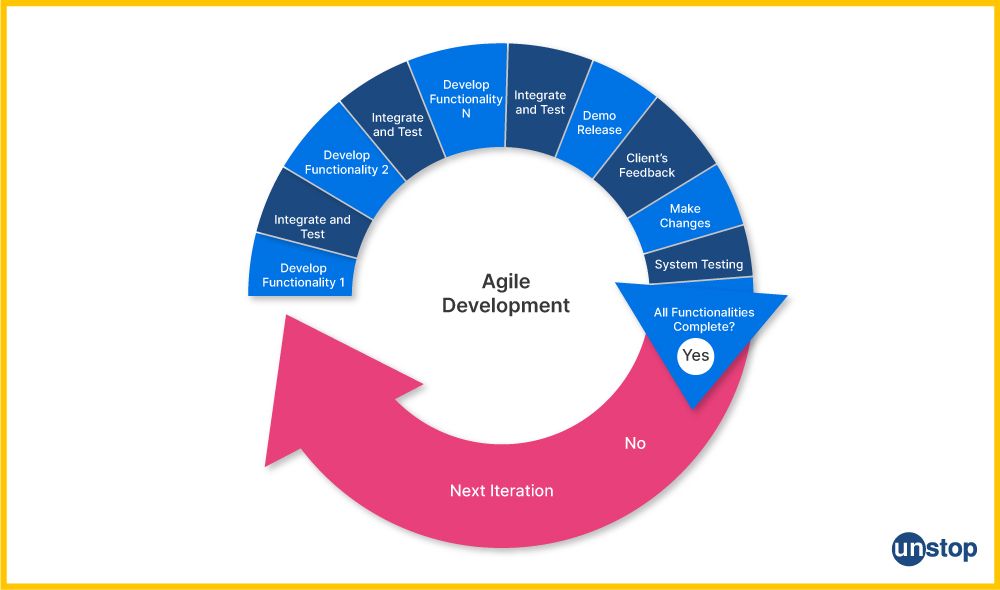
Q19. What is a Burn-Down Chart, and how is it useful in Agile project management?
The Burn-Down Chart is a graphical expression that indicates what remains for a sprint or a particular undertaking. This represents any task that would need to be completed over time and would often take the form of a line chart.
Teams can track progress towards activity goals and immediately correct course so that actions are transparent. A Burn-Down Chart provides the following benefits in Agile project management:
- Progress Tracking: It aids in viewing the team’s growth, allowing them to tell whether they are on schedule to accomplish sprint and project results.
- Early Issue Identification: deviations from the ideal
burn line may indicate a problem in progress or bottlenecks, which should be addressed immediately. - Transparency: It provides stakeholders with a clear view of how the project moves and what is expected at which time for features or tasks.
Q20. Does Agile help with sustainable development in software projects?
Yes, Agile methodologies promote sustainable Development in software projects by focusing on several key principles and practices:
- Work-Life Balance: A healthy work-life balance is stressed out in agile principles for workers. Burnout and stressful factors are minimized over time through overtime reduction of team members’ health.
- Sustainable Pace: The Agile teams work sustainably without the need for extreme deadlines and overtime. It ensures uniformity in work speed, which contributes to enhanced efficiency and employee satisfaction.
- Regular Feedback: Retrospectives are part of agile practices, which enable teams to review their operations and improve, supporting sustainable team performance.
Through the application of these principles and practices, Agile-based teams build a setting conducive to the promotion of sustainability development as far as software construction and employee welfare are concerned.
Q21. Differentiate between Incremental and Iterative Development in Agile.
|
Aspect |
Incremental Development |
Iterative Development |
|
Approach |
Adds new functionality in increments, building upon the existing system. |
Revisits and refines the existing work in cycles. |
|
Primary Emphasis |
Focuses on feature additions and expanding the system. |
Emphasizes continuous refinement and improvement of existing features. |
|
Cycle Length |
Typically longer cycles, where each increment may represent a major milestone. |
Shorter cycles with frequent revisiting and adjustment of work. |
|
Feedback |
Feedback is typically collected after each increment or milestone. |
Feedback is continuously integrated and used to refine work in each iteration. |
|
Risk Management |
Addresses risk by delivering working increments that can be tested and validated. |
Reduces risk through iterations where it identifies, resolves, and improves on them. |
|
Planning and Requirements |
Initial requirements for the entire project may be defined, with adjustments as needed. |
it is anticipated that requirements will evolve and redefined as the project moves on. |
|
Adaptability |
Adapts to changes by accommodating new features with each increment. |
Constant reviews and adjusting workers to suit changing conditions. |
|
Examples |
Developing a website by adding new features, sections, or pages one at a time. |
Enhancing a software application by revisiting and improving its user interface, performance, and functionality in successive iterations. |
Q22. What are the core principles of Lean Software Development, and how do they align with Agile practices?
The core principles of Lean Software Development and their alignment with Agile practices:
- Eliminate Waste: This principle aligns with the Agile value of "Simplicity—the art of maximizing the amount of work not done." Agile also seeks to reduce waste by focusing on essential tasks and features, thus eliminating unnecessary work.
- Amplify Learning: Agile embraces continuous learning and improvement through feedback loops. Practices like retrospectives, daily stand-up meetings, and user feedback are integral to Agile methodologies.
- Decide as Late as Possible: Agile methods, such as Scrum and Kanban, allow changing requirements and decisions to be deferred until the last responsible moment. This promotes adaptability and responsiveness to customer needs.
- Deliver as Fast as Possible: Agile promotes iterative development and frequent, small releases. The Agile principle of "Deliver working software frequently, with a preference to the shorter timescale" aligns with delivering value quickly.
- Empower the Team: Agile emphasizes self-organizing, cross-functional teams with the autonomy to make decisions. This empowerment aligns with Lean's principle of giving individuals the authority and responsibility to improve their work.
- Build Integrity: Agile methodologies encourage building quality into the product from the start. In addition, technologies such as Test-Driven Development(TDD) and continuous integration assist in upholding the integrity of software along with its development progression.
- Focus on Value: Both Lean and Agile are customer-centric. Agile emphasizes delivering value in the form of working software in each iteration. Agile frameworks like Scrum have a product owner role focused on maximizing value delivery.
The core principles of Lean Software Development align with Agile practices by promoting a customer-centric approach, waste reduction, continuous improvement, team empowerment, and adaptability to change. Integrating Lean principles into Agile methodologies enhances their effectiveness in delivering high-quality software products focusing on customer satisfaction.
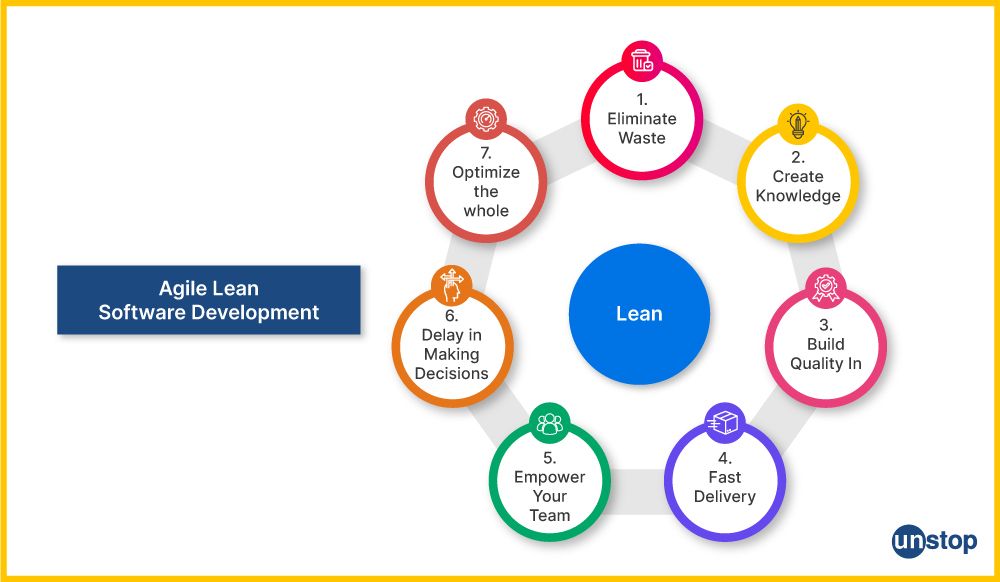
Q23. Discuss why continuous feedback is so important in Agile and how it occurs during the development phase.
In the agile process, continuous feedback becomes vital as the product under Development conforms to client needs and expectations. It occurs throughout the development phase through several means:
- Daily Standup Meetings: These daily check-ins enable team members to share their achievements, identify difficulties, and ask for assistance. It ensures openness and quick problem-solving.
- Sprint Reviews: Stakeholders review what was delivered after each sprint and give feedback, which enables the team to change its course of action accordingly.
- Retrospectives: The organization arranges regular meetings about process improvement. This process involves team members assessing what worked well and what can change in their next sprint, thus allowing for a constant development cycle.
- User Feedback: Involving the users and the relevant stakeholders regularly ensures that the process is adaptable as per their needs.
The feedback process is continuous in agile, enabling a realignment of projects with new needs and changing consumer demands.
Upskill now! Become a pro in as low as INR 199/month
Q24. Explain a Feedback Cycle in Agile and why it is important for iteration.
Collection of input, assessment of results, and revision/adjustment constitute a feedback cycle. It facilitates iterative Development by allowing teams to rework their pieces in small increments as customers provide feedback and requirements keep evolving.
Key aspects of a Feedback Cycle in Agile include:
- Collecting Input: The teams provide continuous feedback to users and stakeholders as well as other participants within the development framework.
- Evaluating Results: Feedback is used to point out where improvements are needed and any problem or opportunity that may need to be enhanced.
- Making Revisions: Customer feedback forms the basis of any improvements required on products or processes to achieve desired results.
However, the key element in agility lies in an interlocking feedback cycle that allows for timely correction of all issues related to work that deviates from customers’ expectations, newly emerged requirements, or ever-shifting conditions and circumstances. It promotes ongoing change and responsiveness.
Q25. How do the quality strategies employed in Agile methodologies contribute to the excellence of the product, and what specific Agile practices enhance the overall quality of the delivered outcomes?
Quality strategies incorporated in Agile methodologies also help guarantee the quality of products being developed. Agile, owing to its emphasis on iterative development practices, continuous feedback and collaborations, uses many strategies that aim to improve product quality. These strategies include:
- Test-Driven Development (TDD): TDD guarantees that any code fragment is rigorously tested during development without bringing defects.
- Continuous Integration (CI): With CI, code changes are frequently integrated into a central repository, followed by automated builds and tests. This strategy enables early uncovering of integration problems and getting a stable, consistent codebase. The fact that continuous integration is reliable enhances the quality of the end product.
- Regular Code Reviews: Regular code reviews promote knowledge sharing, help identify potential issues, and ensure that the written instructions meet established standards. This is a proactive and collaborative approach as it enhances the quality of the product by maintaining code quality and consistency.
- User Stories and Acceptance Criteria: Agile practices are focused on clear user stories and well-defined acceptance criteria. This ensures that all team members and stakeholders have a common understanding of requirements, thus reducing the chances of misunderstandings. It also increases the quality of delivered features.
- Automated Testing: Automated testing involves unit tests and integration. This strategy helps promote the quality of the product because when adding new features or modifications, they can be assured that there will not be unintended side effects or regressions.
- Frequent Inspections and Adaptations: Agile methodologies include frequent inspections by ceremonies such as Sprint Review and Sprint Retrospective. These events enable teams to review the product, collect feedback, and make changes in their processes for continuous improvement, resulting in a masterfully made piece of product.
- Customer Feedback Loops: Agile supports ongoing interactions with customers, getting their feedback during the different phases of progress. This primarily iterative feedback loop ensures that the product developed has satisfied customer needs and hence contributes to the excellence of the final project since it meets real user demands.
Q26. What is a Sprint Backlog in Scrum, and how does it relate to the product backlog and sprint planning?
A Sprint Backlog is a subset of products in the Product Backlog that the team is committed to finishing in a sprint. During Sprint Planning, the team selects these items and plans how they will be delivered in the upcoming sprint, ensuring transparency and focus.
Q27. Can you explain the practice of Pair Programming in Extreme Programming (XP) and how it benefits software development?
Pair Programming involves two developers working together at one computer, one writing code and the other reviewing it in real-time. This increases code quality, minimizes errors, allows for better knowledge sharing, and improves collaboration, leading to a stronger, more sustainable codebase.
Agile Interview Questions - Testing (Basic + Advanced)
Q28. What is Agile testing, and what are the principles of testing?
Agile testing refers to software testing incorporating testing activities into the Agile development process. It involves continuous testing, collaboration, and responding to changes in specified demands. Unlike traditional methodologies, where testing is a separate phase, in Agile, testing is ongoing and iterative, allowing for faster feedback and course correction.
There are seven main principles of Agile Testing, as given below:
- Continuous Testing: Testing should occur consistently throughout the Agile development cycle, ensuring ongoing progress.
- Continuous Feedback: Encouraging the collection of feedback from clients is a key aspect of ensuring that the product aligns with their requirements.
- Team Work or Collective Work: Testing is not exclusive to testers; developers and business analysts can also perform software testing collaboratively.
- Clean Code: Emphasis is placed on maintaining software quality by swiftly addressing errors and defects within the same iteration, ensuring clean, simple, and efficient code.
- Less Documentation: Agile testing relies on reusable checklists instead of extensive documentation, streamlining the process.
- Test-Driven: Unlike traditional methods where testing follows implementation, Agile testing involves concurrent testing during implementation to identify and address issues promptly.
- Customer Satisfaction: Demonstrating development progress to clients during Agile testing allows for adaptability and updates to requirements, ultimately ensuring customer satisfaction.
Q29. Explain the concept of Test-Driven Development (TDD) in Agile.
TDD is one of the practices in Agile, which refers to writing test scripts in advance before one types in code.
The process typically follows these steps:
- Write a Test: The first step in test-driven development is when developers create a failed test case that specifies what is supposed to be done next. The test is usually quite small to focus on a particular functional aspect.
- Write the Code: Developers will then write the minimum code required to make a failed test pass. Often, such code is concerned with the instant functions required.
- Run the Test: The test runs after the code has been written. It is successful if it goes through. Developers can only continue to change the code if they fail at testing.
- Refactor the Code: Since the test is being passed, the developer can redesign it and make it work at an increased performance level.
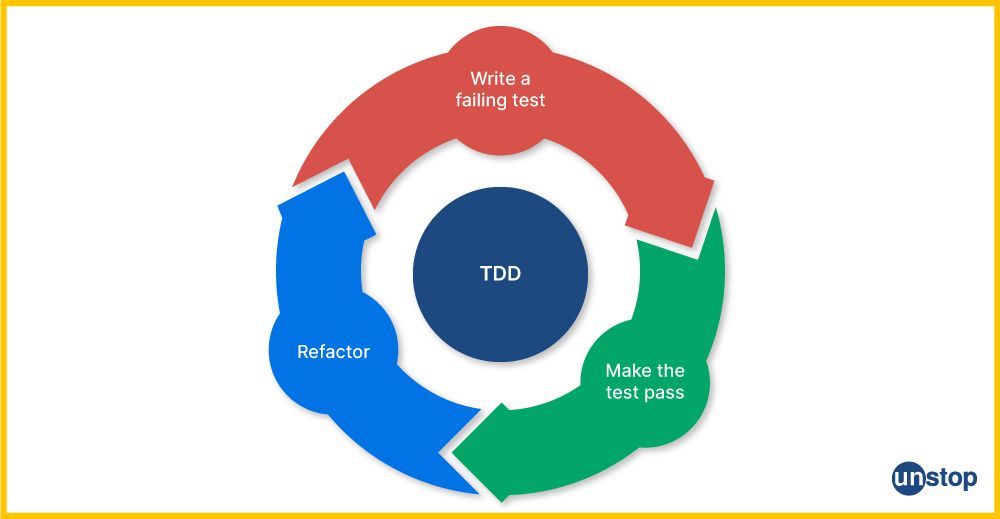
TDD remains critical in Agile since it assures that code is tested properly at the initial stage, minimizing the likelihood of introducing bugs and thus facilitating the smooth maintenance and development of a software system. Secondly, it drives developers toward expected behavior and requirements, which will result in the alignment of development with customer demands.
Q30. How do you ensure effective communication and collaboration between development and testing teams in an Agile project?
Ensuring effective communication and collaboration between development and testing teams is crucial for the success of an Agile project. Here are a few strategies to facilitate collaboration in an Agile environment.
Early Involvement of Testers
- Explanation: Include testing teams right from the start, including Sprint Planning, and when you refine user stories. This ensures that testers clearly understand requirements and can make valuable contributions early in the project's life.
- Benefits: Earlier assessment of possible problems, better test planning, and a high degree of cooperation from the very beginning.
Daily Stand-up Meetings
- Explanation: Run daily sessions referred to as stand-ups, where team members, namely developers and testers, talk about what they are working on or ready for in terms of progress updates & challenges that face them today. This allows for real-time communication and problem resolution.
- Benefits: Better view of team development and fault-finding capabilities, and therefore, collaboration was increased.
Collaborative Sprint Planning
- Explanation: Begin collaborating on Sprint Planning meetings with development and testing teams. This way, everyone is on the same page as far as priorities, timeframes and expectations for incoming sprint.
- Benefits: A shared understanding of goals during sprint, better cooperation and proper planning.
Pair Programming and Pair Testing
- Explanation: Support the practice of pair programming, where one developer and another tester work together on coding tasks and tackling testing issues. It fosters the sharing of knowledge, mutual understanding, and cooperation.
- Benefits: Better communication, faster issue resolution, and superior product quality.
Joint Retrospectives
- Explanation: Organize Sprint Retrospectives where both the development and testing teams review in a meeting what went well and what could have been done better, as well as identify improvement suggestions with cooperative action migration.
- Benefits: Familiar learning, ongoing progress and a comprehensible climate of cooperation and ease.
Clear Definition of Done (DoD)
- Explanation: Define a clear DoD with which the development and testing teams agree. This allows for a mutual consensus about what will complete the user story or task.
- Benefits: Fewer misinterpretations, better product quality, and smooth transfers of authority between departments.
Q31. What is Agile Testing, and how does it promote quick feedback in the software development process?
Agile Testing is an iterative and cooperative approach that assimilates testing in all the periods of the Software Development Lifecycle. It evaluates the software as per changing business needs and promotes quick feedback. This procedure helps find out the problems on time and make a quality commodity related to what the customer needs.
Q32. How does Test-Driven Development (TDD) contribute to technical excellence in Agile testing?
Writing tests before writing or coding and TDD form the basis of an agile practice referred to as test-driven development. Using TDD helps enforce technical excellence by giving specifications about quality measures that should be achieved and functions that must emerge during a development phase. Through this process, developing stronger, more stable, and better-tested software becomes achievable.
Q33. How do you ensure effective implementation of Agile testing methods and navigate the Agile testing process to maintain high-quality software deliverables?
Ensuring effective implementation of Agile testing methods and navigating the Agile testing process involves several critical practices:
Early and Continuous Testing:
- Start testing activities as early as possible in the development cycle.
- Conduct continuous testing throughout the Agile iterations to catch defects early.
Collaboration and Communication:
- Foster close collaboration between development, testing, and other stakeholders.
- Facilitate open communication to address issues and align on quality goals quickly.
Test Automation:
- Prioritize test automation to achieve faster feedback and continuous integration.
- Automate repetitive and critical test cases to enhance efficiency.
Cross-Functional Teams:
- Promote cross-functional teams where testers work closely with developers and other team members.
- Encourage collective ownership of quality within the group.
User Stories and Acceptance Criteria:
- Participate in creating clear and comprehensive user stories with well-defined acceptance criteria.
- Use these criteria as a basis for testing and validation.
Regression Testing:
- Implement effective regression testing to ensure new changes do not negatively impact existing functionality.
- Utilize automation for regression testing to save time and provide thorough coverage.
Continuous Integration and Continuous Deployment (CI/CD):
- Integrate testing into the CI/CD pipeline for automated and frequent builds.
- Enable rapid and reliable deployment of software changes.
Adaptability to Change:
- Embrace changes in requirements and priorities, adjusting testing efforts accordingly.
- Ensure that the testing process is flexible and responsive to evolving project needs.
Feedback Loops:
- Establish feedback loops with stakeholders, including end-users, to gather insights early and often.
- Use feedback to refine testing strategies and improve overall software quality.
Metrics and Monitoring:
- Implement metrics to track testing progress, identify bottlenecks, and assess the effectiveness of testing efforts.
- Monitor key performance indicators to ensure continuous improvement.
By incorporating these practices, Agile testing teams can navigate the testing process effectively, promote collaboration, and contribute to delivering high-quality software in iterative and incremental development cycles.
Q34. What is the Definition of Done (DoD) in Agile testing, and how does it relate to high-quality product delivery?
Agile Testing Definition of Done refers to the criteria or conditions that should be satisfied for a user story, feature, or task when handing it over as complete, ready, and fit for release. It works as a common definition of the quality and completeness targets that should be reached for every working item by members within the Agile team. The DoD is crucial in ensuring high-quality product delivery for several reasons:
- Quality Assurance: The DoD serves as a checklist that defines what attention to detail must be given when producing deliverables regarding functionality, performance security, and good user experience. By following the DoD, this team guarantees that the product stays a certain level of quality.
- Clear Expectations: The DoD is transparent on what constitutes a completed task and informs about expectations for the work. This clarity reduces the chances of misunderstandings within a team and makes everybody's understanding about what level of completeness each work item must achieve.
- Prevention of Technical Debt: Sticking to the DoD can prevent technical debt that constitutes cost rework or maintenance from using short-term solutions and compromising quality. The team reduces the risk of technical debt by identifying and resolving problems within the DoD.
- Incremental Improvement: The DoD is not stringent and can evolve over time due to lessons adopted plus changes in project requirements. Such flexibility fosters ongoing enhancement and enables the team to set a higher standard on quality rules in further releases.
- Collaboration and Communication: DoD is used for collaboration with team members developers, testers and product owners. It makes communication easier by giving people one kind of language and a common set of expectations so that everyone is always clear about what gets done in order for a task to be seen as finished.
- Customer Satisfaction: Adhering to the DoD ensures that the product delivered at the end of each iteration meets the agreed-upon quality standards. Regularly providing high-quality increments to customers enhances their satisfaction and confidence in the team's ability to deliver a reliable product.
Q35. How do Agile testing methodologies adapt to changing business requirements during the software development cycle?
Agile testing methodologies embrace change by continuously re-evaluating and reprioritizing backlog items. Testers are closely involved in the development process to keep track of business requirement changes and revise test cases accordingly. The flexibility in Agile teams offers quick responses to changing customer needs and market dynamics.
Q36. What is the difference between the release burn-down chart and the sprint burn-down chart?
|
Aspect |
Release Burn-down Chart |
Sprint Burn-down Chart |
|
Scope of Measurement |
Spans the entire project or a significant phase of the project. |
Limited to a single sprint duration (typically 2-4 weeks). |
|
Time Frame |
Represents the progress over the entire project timeline. |
Captures progress within the specific duration of a sprint. |
|
Objective |
Tracks the completion of the overall project scope. |
Monitors the completion of planned work within a sprint. |
|
Granularity |
Typically shows a higher-level view of progress. |
Provides a detailed view of daily progress during the sprint. |
|
Frequency of Updates |
May be updated less frequently, such as at the end of each release or major iteration. |
Updated daily or throughout the sprint to reflect real-time progress. |
|
Stakeholder Visibility |
More focused on providing insights to higher-level stakeholders and executives. |
Primarily used by the development team for day-to-day tracking. |
|
Use Case |
Helps in long-term planning, aligning with project milestones and deadlines. |
Assists the team in managing and adjusting work during the sprint. |
|
Incorporation of Changes |
Adjustments may be made, but they often align with major planning or release changes |
Allows for frequent adjustments and adaptation within the sprint based on emerging requirements or impediments. |
|
Completion Criteria |
Represents the completion of the entire project scope. |
Indicates the completion of user stories or tasks within the sprint backlog. |
|
Long-term Predictions |
Can be used to make predictions about the project's overall completion date. |
Focuses on short-term predictions for the completion of the sprint backlog. |
|
Example Scenario |
A release burn-down chart might track the progress of features across multiple sprints towards the final product release. |
A sprint burn-down chart could show the daily progress of user stories within a specific sprint, helping the team manage workload and meet sprint goals. |
Q37. Why is quick delivery of software increments important in Agile testing, and how does it support the Agile principles?
Quick delivery in Agile testing ensures that features or fixes are released sooner, providing customer value faster. It conforms with the agile principle of daily working software and focuses on the customer approach. Such delivery is also conducive to enabling rapid feedback and faster adjustment to evolving needs.
Q38. How does Agile testing differ from the traditional Waterfall model, and what advantages does it offer in testing efficiency and success?
There are many differences between agile testing and the waterfall model. This contrasts Waterfall's linear and sequential nature, which does not cater for continuous testing during the development cycle. Agile also fosters working together of the teams for development and testing, while in Waterfall, they are usually divided. The differences make testing more efficient, identify issues quickly and easily, and enhance the project's probability of success than for Waterfall.
|
Aspect |
Agile Testing |
Waterfall Model |
|
Development Approach |
Testing efficiency relies on thorough documentation and phase-specific testing. |
Sequential and linear, with a separate testing phase after development. |
|
Flexibility |
Highly flexible and adaptable to changing requirements, with continuous feedback. |
Less flexible and resistant to changes once the project has progressed. |
|
Testing timing |
Continuous testing throughout the development process. |
Testing occurs after the development phase is complete. |
|
Customer Involvement |
Extensive customer involvement and feedback throughout the project. |
Limited customer involvement until the end of the project. |
|
Testing Efficiency |
Early defect identification and resolution, resulting in more efficient testing. |
Testing efficiency relies on thorough documentation and phase-specific testing. |
|
Adaptability to Change |
Easy adaptation to changing requirements due to iterative nature. |
Less adaptable to changing requirements without significant project impact. |
|
Cost Management |
Costs are distributed evenly throughout the project. |
Costs are often concentrated in the testing and debugging phase. |
|
Risk Management |
Frequent risk assessment and mitigation opportunities. |
Risk management mostly occurs at the beginning of the project. |
Q39. Explain the role of the Scrum of Scrums in large-scale Agile testing. Why does it aid in the coordination of testing efforts among various teams?
In large-scale Agile projects, Multiple Agile teams also work together to deliver complex products in case of large-scale Agile projects. A coordination mechanism through a meeting of the Scrum of Scrums from different teams addressing testings, developmental problems, progress updates, and dependencies.
It aids in the coordination of testing efforts in the following ways:
- Dependency Identification: It helps teams detect and resolve intergroup issues likely to affect testing progress. The Scrum of Scrums helps them to share information and thus address issues effectively.
- Alignment: Scrum of Scrums is a formulation that eliminates instances where testing efforts do not align with the whole project and timelines, as well as team bottlenecks.
- Communication: It promotes good teamwork among groups since testing plans and outcomes will be sent out.
The inclusion of Scrum of Scrum greatly facilitates joint work and production of complex products by separate teams in an Agile Large-Scale Testing environment.
Q40. How would you apply Feature-Driven Development principles in your approach to testing product features?
Applying Feature-Driven Development (FDD) principles to testing product features involves a strategic and collaborative approach. Here's how one might address this:
Feature-Centric Test Planning:
- Identify and prioritize features based on business value and customer needs.
- Develop a test plan that aligns with the feature set, focusing on critical paths and high-priority functionalities.
Iterative Testing:
- Align testing cycles with the iterative nature of FDD, addressing features incrementally.
- Conduct testing for each feature as developed, ensuring early defect detection and rapid feedback.
Collaboration with Development Teams:
- Foster close collaboration between testing and development teams to understand feature requirements and design.
- Participate in feature walkthroughs and discussions to ensure comprehensive test coverage.
Automated Testing for Repeated Features:
- Identify features that are likely to be repeated or reused in different parts of the application.
- Implement automated testing for such features to enhance efficiency and maintainability.
Traceability and Documentation:
- Maintain traceability between features and test cases to ensure comprehensive coverage.
- Document test scenarios, expected outcomes, and any specific feature-related testing considerations.
Regression Testing:
- Implement effective regression testing to verify that new features do not negatively impact existing functionalities.
- Utilize automation for regression testing to save time and ensure thorough coverage.
User Acceptance Testing (UAT) Collaboration:
- Collaborate with end-users during UAT to ensure that features meet their expectations and business requirements.
- Incorporate user feedback into the testing process for continuous improvement.
Feedback Loops:
- Establish feedback loops with development teams, incorporating insights into the testing process.
- Use feedback to adapt testing strategies and improve the overall quality of tested features.
Parallel Testing for Concurrent Features:
- Identify features that can be developed concurrently.
- Implement similar testing efforts to accommodate the simultaneous development and testing of multiple features.
Metrics and Reporting:
- Utilize metrics to track feature testing progress, identify bottlenecks, and assess the effectiveness of testing efforts.
- Provide regular reporting on feature testing status to relevant stakeholders.
By incorporating these practices, one can effectively apply Feature-Driven Development principles to testing product features, ensuring a comprehensive and quality-focused approach throughout the development lifecycle.
Agile Interview Questions- Methodology [Basic+ Advanced]
Agile methodology is an adaptable and iterative approach to software development that prioritizes adaptability and customer collaboration. It breaks down projects into smaller, manageable increments known as sprints, where cross-functional teams work collaboratively to deliver working software. Agility provides immediate information, and change can be done during the project. Value to customers within a short period is the main focus. Unlike traditional sequential development methods, it fosters a flexible project management method.
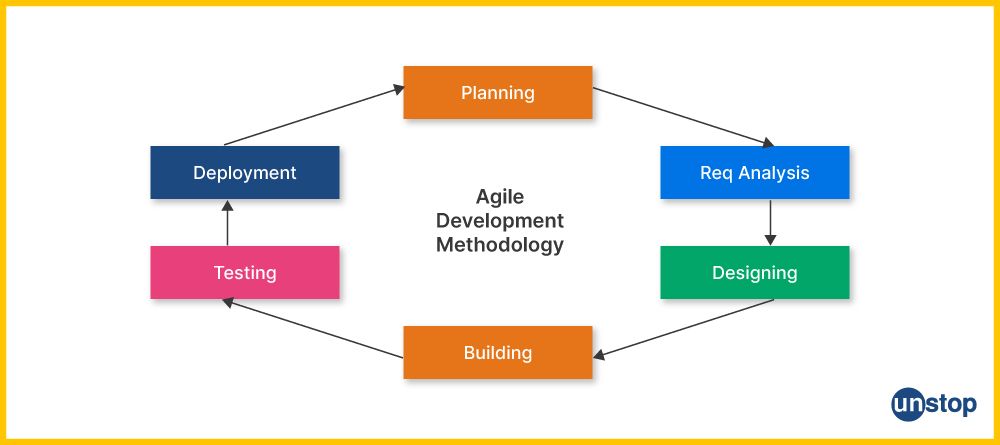
Q41. What are the core principles of Agile methodology, and how do they guide software development practices?
Agile methodology is guided by the following:
- customer collaboration,
- responding to change,
- delivering working software and
- individuals and interactions over processes and tools.
These principles prioritize flexibility, customer satisfaction, adaptability, and human-centric approaches in agile software development practices.
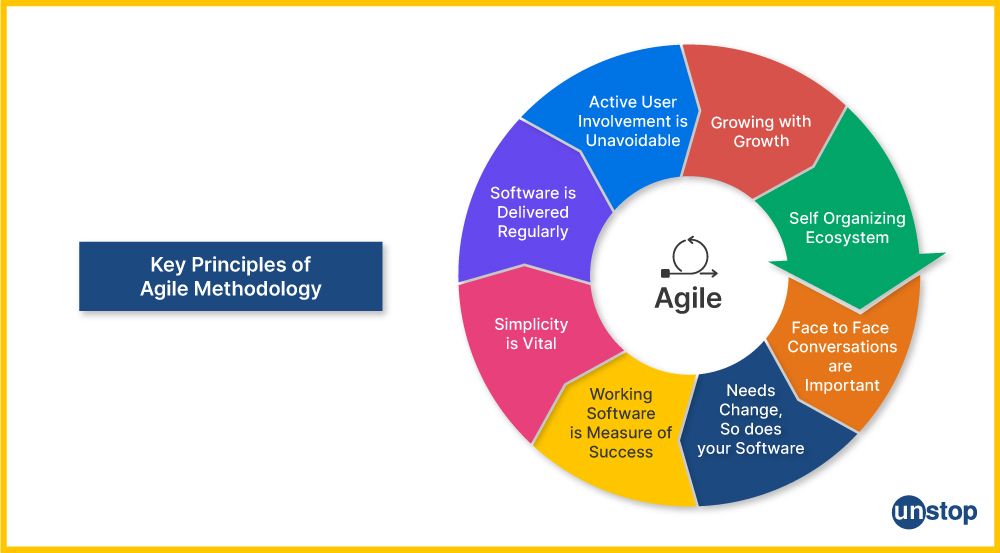
Q42. What is the significance of planning poker in Agile project development, and how does it contribute to project estimation and prioritization?
Planning Poker refers to a project planning process that calculates values and prioritizes product elements in an iterative model such as User Story. This is a collaborative process that includes team members like developers and testers as the key decision markers.
Here's how it contributes to project estimation and prioritization:
- Team Involvement: Planning poker involves every team member in the estimate process. This enables the sharing of perspectives from all the parties and hence promotes collaboration, discussion, and consensus-building among peers.
- Reliable Estimates: The team members need to discuss various perspectives on the same scenario to improve the efficacy and reliability of their estimated efforts of performing the task.
- Prioritization: Moreover, planning poker can be applied for purposes of both estimating and prioritizing. The team will determine the priority of each backlog item by assigning story points (effort estimates) as an estimate of its value and complexity.
- Transparency: It is a simple process that is transparent, and all people's inputs are considered. By so doing, this enhances stakeholders' and team members' understanding of what is required, making them all understand on the same frequency.
Planning Poker helps establish a common ground for communication within an Agile team regarding project development.
Q43. What are the key principles of the Crystal Methodology, and discuss how it aligns with Agile development methodologies?
Key Principles of Crystal Methodology:
- People-focused: Underscoring the need for qualified people and proper interaction in a project team.
- Frequent Delivery: Continuously delivers workable software for regular feedback provision and accommodations in response to emerging changes.
- Reflective Improvement: Motivates team members to assess their process and provide feedback to refine practice.
- Sensitivity to Project Complexity: It takes a flexible outlook in its procedures, depending on the degree of complexity, and offers suitable strategies for every range of complexity.
- Early Delivery of High-Value Features: Provides business value by introducing new features early in the development cycle.
Alignment with Agile:
Crystal Methodology embodies aspects of individual and interaction, working software, customer collaboration, and responsiveness to changes, which formulates the basic Agile principles. The first approach emphasizes flexibility, adaptation, and development in a cyclical way to add value to the customer.
Q44. Explain the importance of iterative development, and how it contributes to delivering successful software projects?
- Importance of Iterative Development in Agile and Contributions to Successful Software Projects: Agile development employs an iterative approach, breaking down the project into small, manageable iterations or sprints.
- Early and Continuous Feedback: This iterative development approach facilitates frequent reviews of deliverables during their ongoing production. Stakeholders give input along the way, thus decreasing the chances of misinterpretations and achieving what customers expect.
- Adaptability to Change: Iterations allow modification by emerging requests. The ability to adapt ensures that the software is tuned to customers’ requirements and the changes in the market.
- Risk Mitigation: Breaking down functions into manageable chunks permits a continuous risk reduction throughout development. It helps to cushion against the effect of unexpected events, resulting in increased project predictability.
- Faster Time-to-Market: It produces a potentially shippable product increment for each iteration. These facilitate frequent releases that enable quick time-to-market and positioning in a competitive business landscape.
- Continuous Improvement: Iterative development fosters a culture of continual improvement. At each iteration, teams review what worked and could be improved in processes, collaboration, and product quality.
Q45. What is the role of the Project Owner in Agile methodology, and how does effective communication with the team contribute to project success?
In Agile methodology, the Project owner determines business needs and priorities and communicates with a customer vision to a team. It makes communication effective in a team such that development should be according to customers’ requirements. This, in turn, enhances product quality, improved customer satisfaction, and successful project realization.
Q46. In the context of Agile development methodology, how do you integrate software testing techniques to ensure comprehensive test coverage?
Software testing should be integrated into all the activities necessary to implement Agile development methodology successfully. Next, test activity is tightly coupled with development iterations.
Teams can use strategies like TDD—where tests come before code, or BDD—focused on developer/non-developer collaboration—to ensure that "testing" is not a separate but intrinsic part of developing. Moreover, the routine tests are automated and can be executed very fast and repeatedly at every moment when the evolving codebase needs validations.
The company adopts a continuous testing and integration approach whereby software testing is not considered a standalone activity but a constant and parallel practice during the entire development cycle. This approach ensures a high level of thoroughness in testing, leading to the belief that what has been developed is a quality product.
Q47. Explain the Scrum cycle in Agile methodology and its role in achieving frequent deliveries of working software.
The Scrum cycle is an essential component of the Agile methodology, especially in relation to the Scrum framework. It comprises several important activities and roles that are interrelated to ensure frequent software releases in working conditions. The Scrum cycle includes the following elements:
Roles:
- Product Owner: Represents both stakeholders, incorporates product backlog and prioritizes work.
- Scrum Master: Functions as a Scrum Master, removes barriers and pursues adherence to the principles of Scrum.
- Development Team: Soldiers responsible for providing the product’s increment.
Events:
- Sprint Planning: (Sprint Kick-off Meeting) A collaborative meeting at the beginning of a sprint where the team plans what work is to be done during that particular sprint.
- Daily Stand-up: The meetings are brief daily, with team members discussing.
- Sprint Review: In a final sprint meeting, the team will show all tasks performed during a period for stakeholders.
- Sprint Retrospective: A wrap-up meeting at the end of a sprint, where team members talk about what went well and did not go so well over that particular sprint. They also plan for changes to be made during subsequent iterations.
Artifacts:
- Product Backlog: A task definition list of features, improvements, and bugs, which is the work needed to be done on the project.
- Sprint Backlog: The team commits to deliver a subset of the product backlog during the sprint.
- Increment: This is the cumulative complete set of all product backlog items completed at the end of a sprint, which should be in a “potentially releasable” state.
Role of Scrum Cycle in Achieving Frequent Deliveries:
- Time-Boxed Sprints: Sprints are a set period of time (usually 2 – four weeks) during which the team performs on some predefined group of work. This limits the life cycle of each product, thus exerting consistent pressure on releasing new products.
- Iterative Development: The Scrum cycle focuses on the aspect of iterative development, where there are regular increments that are delivered at the end of each sprint. This permits ongoing feedback and allows stakeholders to have measurable progress often.
- Adaptability: The Scrum framework allows teams to adjust and update their product backlog at the final sprint based on changing requirements or priorities. This flexibility supports the delivery of such valuable features that can change with changed demands.
- Continuous Feedback: Events like the Sprint Review and Sprint Retrospective regularly occur to provide opportunities for continuous feedback for stakeholders and team members. This loopback assists in refining the product and enhancing developmental practices over time.
- Transparency: The Scrum cycle fosters openness by demonstrating the progress and obstacles encountered noticeably for everything related to teamwork and stakeholders through artifacts such as Sprint Backlog, burndown charts, or product increments. This openness creates trust and positive collaboration.
- Continuous Improvement: Sprint Retrospective is a special time for the team to review their processes and find areas to enhance their performance. This commitment to ongoing change creates more efficiency and effectiveness in future sprints.
Q48. What is the role of a Professional Scrum Master in Agile methodology, and how does it contribute to effective team collaboration and Agile practices?
A Professional Scrum Master ensures that there is an effective working of a team and Agile practices. Therefore, they act as coaches and guides who ensure that the team follows the Agile concepts. They are barrier removers who pave the way for Agile practices and enhance teamwork synergy. On the other hand, a great Scrum Master works to develop teams’ cohesiveness, providing a positive working environment, allowing continuous development, and making sure that everybody behaves according to Agile principles.
Q49. Explain how Agile methodology accommodates quick feedback and why this feature is essential for success.
Quick feedback is provided within the iterative and incremental nature of the agile methodology. It helps deliver working software increments with short development cycles, usually in time-boxed iterations or sprints. Using a frequent release cycle, various stakeholders, such as end-users and product owners, can quickly contribute their suggestions concerning the deliverables.
The quickness of review periods that include sprints and demo sessions facilitates the continual validation of a product in relation to changing needs. This becomes crucial for success as it ensures the development meets user expectations and business requirements.
The integration of immediate feedback helps resolve problems as they develop; it gives room for modification and enables consistent growth during product development. The iterative feedback loop constitutes a pillar for Agile's capability to provide practical, dynamic, and responsive high-quality, customer-oriented software.
Tips to help you prepare for an Agile interview as a developer
Here are some tips to help you succeed in an Agile interview:
- Understand Agile Principles and Frameworks: Understand the Agile Manifesto’s twelve principles and basic knowledge. Familiarize yourself with popular Agile frameworks such as Scrum, Kanban, or XP.
- Review Agile Practices: Know about the popular Agile routines such as the daily check-in, sprint meeting, sprint presentation, and retrospective. Make sure you are ready to speak about how you have used these strategies at your previous jobs.
- Know Your Role: Be sure to explain what you are responsible for or, depending on your role (as Scrum Master, Product Owner, or developer), your contributions to the Agile process and how you interact with the team.
- Share Real-World Examples: Provide samples of your previous experience with Agile. State what challenges were encountered, what was done about them, and how successful it was.
- Technical Skills: Ensure you are well prepared for conversations regarding your technical Agile skills. Therefore, for instance, if you are a developer, it could be about version control, continuous integration, and automated testing.
- Collaboration and Communication: Highlight your competence in working with Agile teams and communication skills. Describe instances of promoting communication and conflict resolution.
- Scenarios and Problem-Solving: Answers to scenario-based questions on how a candidate’s decision-making skills should work in an Agile environment. Solve Agile-related problems of practices or scenarios.
- Soft Skills: Soft skills like adaptability, collaboration, or ability to go with the change that is rated in Agile systems.
- Research the Company: To do this, grasp what kind of Agile your company has, its maturity level (how developed it is), and particular challenges. Tailor your responses accordingly.
Tips to help you prepare for an Agile interview as a manager
Here are some tips to help you prepare for an Agile interview as a manager:
- Understand Agile Principles and Frameworks: Ensure you understand the Agile Manifesto and its 12 principles well. Familiarize yourself with most Agile approaches such as Scrum, Kanban, and XP.
- Leadership and Facilitation: Demonstrate how you will lead the Agile team and maintain the team dynamics. Make sure you are prepared to talk about how you have led and inspired teams to obtain their Agile targets.
- Team Collaboration: Highlight your skills in building cooperation and communication in Agile teams." Provide instances of how you dealt with conflicts and created a harmonious workforce.
- Agile Metrics and Reporting: Be prepared to discuss the use of Agile metrics and reporting used in prior works. These indicators include velocity, burndown chart, and cumulative flow diagrams.
- Change Management: Discuss your experience managing and leading organizations to embrace Agile approaches. Sharing of successful projects along with lessons learned.
- Technical Knowledge: Explain the technical skills you possess as supported by Agile philosophy, depending on your background. They could be the knowledge of such practices as version control, continuous integration, or even automated testing.
- Cultural Fit and Agile Mindset: Focus on your Agile mindset and core values and create the organization's Agile environment.
- Research the Company: Understand the company's current Agile practices, challenges, and the state of Agile adoption within the organization. Tailor your responses to show how you can address these specifics.
- Demonstrate Agile Success Stories: Give particular instances where Agile has been successfully implemented and identify the results and improvements made during this implementation due to your participation.
- Soft Skills: Emphasize soft skills such as adaptability, solving problems and communicating, which are essential in Agile management.
In this article, we have tried to cover essential areas that provide insights into all the important topics of the Agile approach. The principles and practices of Agile continue to influence how teams work, adapt, and deliver value in multiple domains, making it a pillar for modern project management methodologies. So revise all the key concepts well and nail your job interview. All the best!
You may also like to read:
- Do-While Loop In C Explained With Detailed Code Examples
- Ternary (Conditional) Operator In C Explained With Code Examples
- Identifiers In C | Rules For Definition, Types, And More!
- Tokens In C | A Complete Guide To 7 Token Types (With Examples)
- Constant In C | How To Define & Its Types Explained With Examples
As a biotechnologist-turned-writer, I love turning complex ideas into meaningful stories that inform and inspire. Outside of writing, I enjoy cooking, reading, and travelling, each giving me fresh perspectives and inspiration for my work.
Login to continue reading
And access exclusive content, personalized recommendations, and career-boosting opportunities.
Subscribe
to our newsletter
















Comments
Add comment